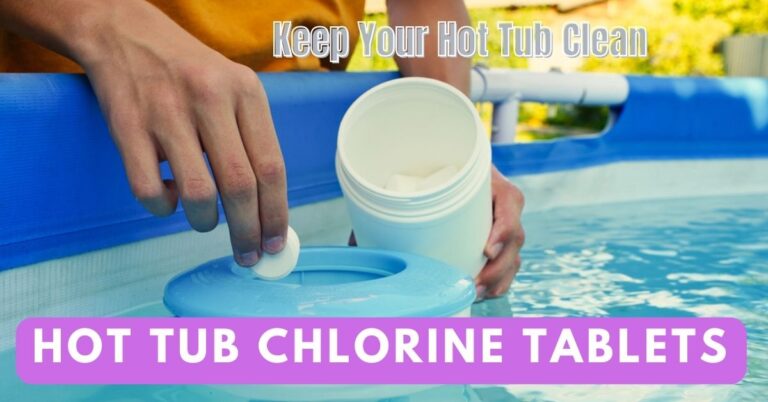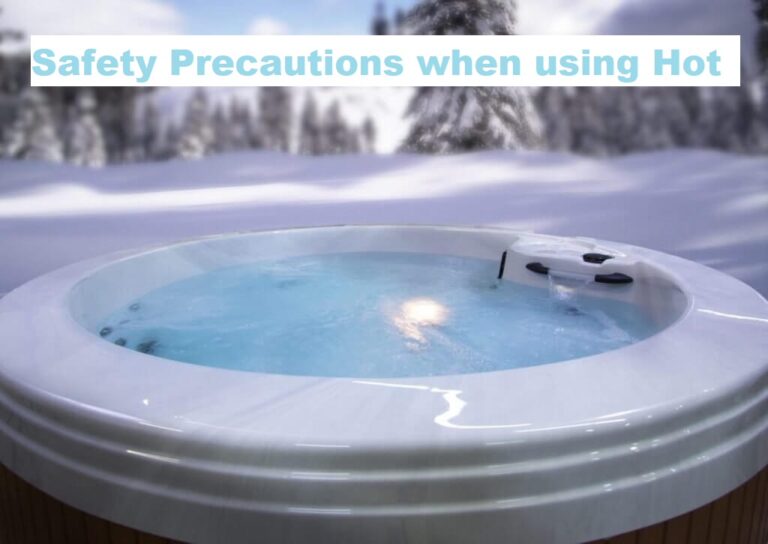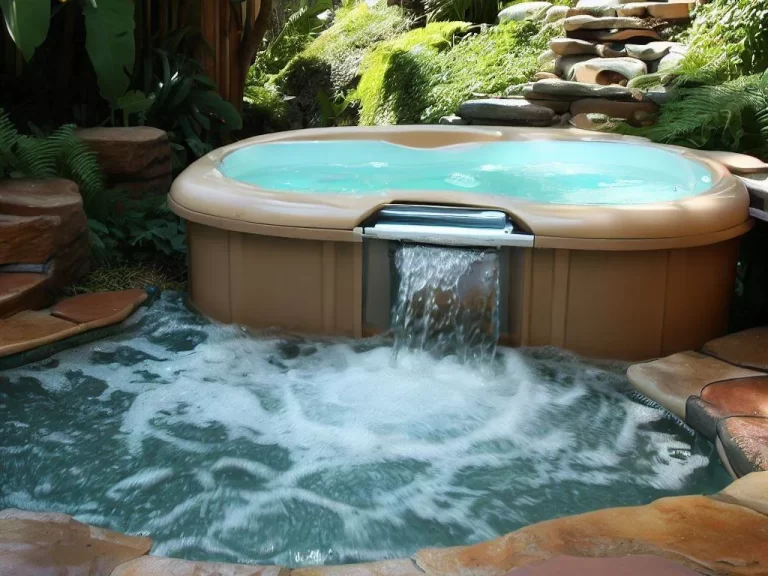Guide to Pool Closing: Costs, Chemicals, and Services Explained
Closing your pool for the winter might feel like a daunting task, especially if you’re unsure about where to start or what’s involved.
Whether you’re an above-ground pool owner looking for a simple DIY solution, or you’ve got an inground pool and need expert help, the process can raise a lot of questions.
You might be worried about using the right chemicals, finding a trustworthy service, or even how much it’ll cost. And if you’re thinking about permanently closing your pool, it can seem even more overwhelming.
But don’t worry, you’re not alone. In this guide, we’ll walk you through everything you need to know to safely and effectively close your pool for the winter.
We’ll also cover tips on choosing the right service if you’d rather not handle it yourself. Whether you’re looking for step-by-step instructions, information on costs, or guidance on permanent pool closures, we’ve got you covered.
Let’s get started and make pool closing one less thing to stress about this season!
Why Closing Your Pool Correctly Matters
Without proper winterization, freezing temperatures can damage your pool’s pipes, pump, and structure. And if algae take hold, you’ll be looking at a time-consuming and costly cleanup.
Whether you have an above-ground or inground pool, following the right steps ensures that your pool stays safe over the winter. At Hot Tub Patio, we know how important it is to close your pool properly, and we’re here to guide you through the process so you can enjoy a smooth, hassle-free opening next summer.
Tools & Materials
Before you begin closing your pool, gather the essential tools and materials to make the process smooth and efficient. Here’s what you’ll need:
- Pool closing kit: Tailored for both above-ground and inground pools, this kit contains the necessary chemicals and tools for winterizing your pool.
- Pool chemicals: Ensure you have chlorine, algaecide, and other essential chemicals to keep the water balanced and algae-free throughout winter.
- Winter pool cover: A solid or mesh cover is crucial to protect your pool from debris and prevent water contamination during the off-season.
- Safety cover (optional): For added peace of mind, especially if you have pets or children, a safety cover is a great option.
- Pool antifreeze: If you live in an area where temperatures drop below freezing, this will protect your pipes from freezing and cracking.
- Cleaning tools: Don’t forget the basics—vacuum, skimmer, and brush—to thoroughly clean the pool before closing.
Having these materials on hand will save you time and ensure your pool is properly prepared for winter.
Step-by-Step Guide to Closing Your Pool
(For Both Above-Ground and Inground Pools)
Following these steps ensures your pool stays protected and algae-free throughout the winter season, saving you time and effort when it’s time to reopen in the spring.
Step 1: Clean Your Pool Thoroughly
Key Problem: Many pool owners skip cleaning before closing, which often leads to algae growth during the winter.
- Remove all leaves, twigs, and debris from the pool.
- Brush the pool walls and floor to remove any dirt or algae.
- Vacuum the entire pool thoroughly, paying extra attention to corners where debris tends to accumulate.
Step 2: Balance the Water Chemistry
Key Problem: Improper water balance can cause damage to your pool and equipment over the winter months.
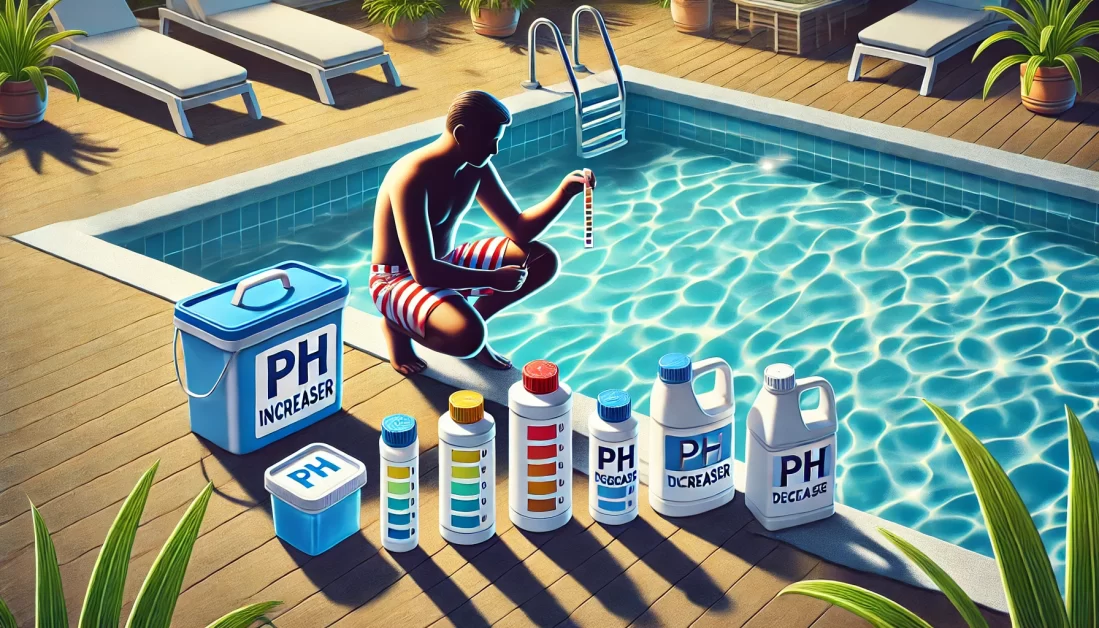
- Use a water testing kit to check pH, alkalinity, and calcium hardness levels.
- Adjust the pH to between 7.2 and 7.6, and ensure the alkalinity is between 80–120 ppm.
- Add the appropriate winterizing chemicals to prevent scale buildup and algae growth.
Step 3: Shock and Chlorinate Your Pool Water
Key Problem: Failing to shock the pool before closing can leave it vulnerable to bacteria and algae growth.
- Add a shock treatment to boost chlorine levels and sanitize the water.
- Once the shock has worked, apply a long-lasting algaecide to prevent algae buildup over the winter.
Step 4: Lower the Water Level
(for Inground and Above-Ground Pools)
Key Problem: Pool owners are often unsure how much water to drain before covering the pool.
- For above-ground pools, lower the water level just below the skimmer.
- For inground pools, follow the manufacturer’s instructions or reduce the water level to a few inches below the skimmer, depending on the type of pool cover you’ll be using.
Special Considerations for Different Pool Types
Taking these extra steps ensures your pool, whether above-ground or inground, will stay in great condition through the cold months and be ready to use again when the warmer weather returns.
A. Closing an Above-Ground Pool for Winter
When closing an above-ground pool, there are a few unique steps to ensure it stays protected through the winter:
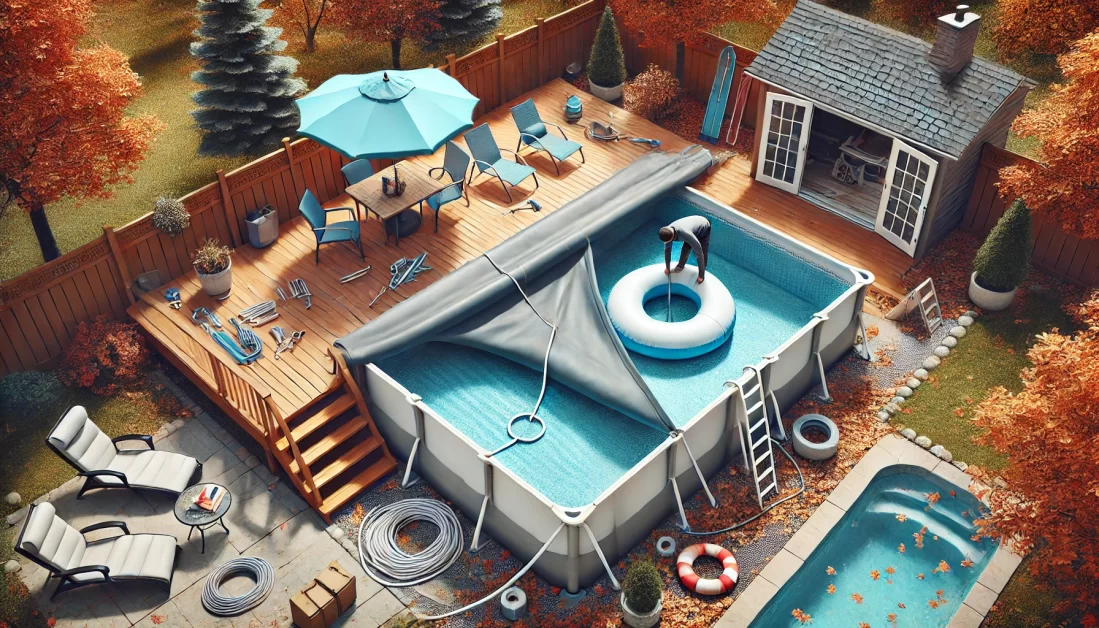
Add an air pillow: Place an air pillow in the center of the pool beneath the winter cover. This pillow helps distribute ice pressure evenly, reducing the risk of damage to the pool walls. Make sure not to overinflate it, as it needs space to expand with the cold.
Install the winter cover securely: Stretch the winter cover across the pool, ensuring it’s tight and secure. Use a cable and winch or winter cover clips to keep it in place, especially in areas with strong winds. Make sure the cover is free of gaps to prevent debris from entering.
B. Closing an Inground Pool for Winter
For inground pools, winterization requires more focus on protecting plumbing and equipment from freezing temperatures:
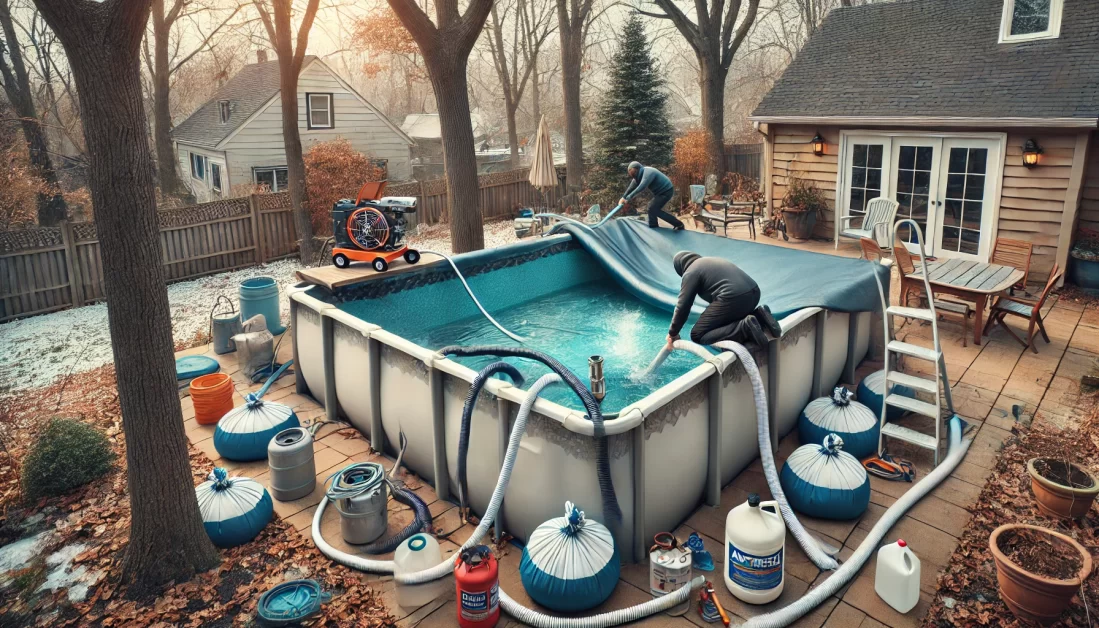
Blow out and drain the pool lines: Using an air compressor, blow out all water from the pool’s plumbing lines. Any water left inside can freeze and expand, leading to cracked pipes and costly repairs. Once the lines are clear, add pool antifreeze to further protect them.
Plug skimmers and returns: Insert winter plugs into the skimmer and return lines to block water from re-entering the pipes. This step is crucial to prevent frost from damaging the plumbing system during freezing temperatures.
Winterizing Pool Equipment
Properly winterizing your pool equipment is crucial to avoiding expensive repairs when it’s time to reopen in the spring.
- Turn off and winterize the pump, filter, and heater: Begin by turning off the pool pump, filter, and heater. If your filter has a multiport valve, set it to the “winterize” position. Be sure to disconnect all hoses and equipment that might have water inside to prevent freezing damage.
- Drain all equipment: Drain any water left in the pump, filter, and heater to prevent freezing and cracking during the winter months. For cartridge or sand filters, clean and remove any remaining water inside before storing.
- Store pool accessories properly: Remove ladders, skimmer baskets, diving boards, and any other accessories. Clean them thoroughly, let them dry, and store them in a dry, safe place for the winter.
Key Problem: Many pool owners forget to properly winterize their equipment, leading to costly repairs for cracked pipes, damaged pumps, and broken heaters.
Taking these steps ensures that your equipment is protected, saving you both time and money when reopening the pool next season. Check out the Swimming pool guide.
Install a Winter Pool Cover
Choosing the right pool cover and installing it properly is key to keeping your pool clean and protected during the winter months.
| Type | Purpose | Maintenance | Secured By | Best For |
|---|---|---|---|---|
| Winter Cover | Blocks debris | Remove water/snow regularly | Water bags or blocks | Debris protection |
| Safety Cover | Blocks debris & prevents falls | Minimal | Anchored to deck | Homes with kids/pets |
- Tips for Securing the Cover: To secure a winter cover, ensure it fits tightly with no gaps. Use a cable and winch system or clips for above-ground pools, and water bags or weights for inground pools. Distribute evenly to prevent sagging.
- Keep Debris Off the Cover: Remove leaves, snow, and water from the cover during winter to prevent sagging or tearing. Use a pool cover pump or broom to keep it clean and prevent contaminants from entering the pool.
Pool Closing Kits & Chemicals
Choosing the right pool closing kit and understanding the chemicals included are essential steps for properly winterizing your pool. Here’s a breakdown of what you need to know:
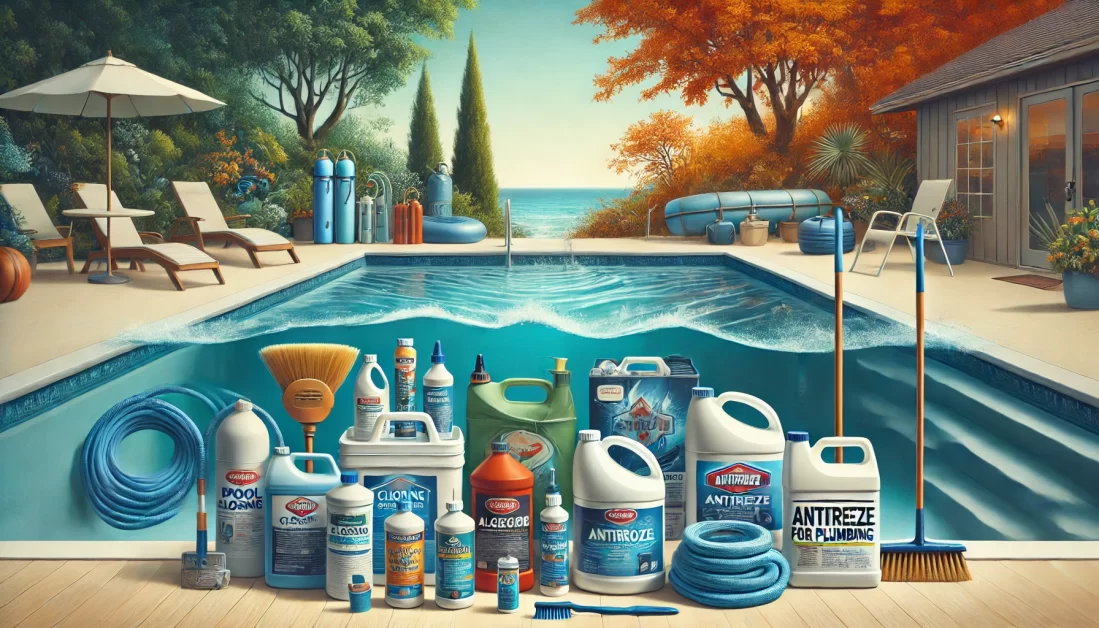
Recommended Pool Closing Kits
- For Above-Ground Pools: Most kits for above-ground pools contain the necessary chemicals in the right amounts for smaller water volumes. These include chlorine, algaecide, and winterizing solutions.
- For Inground Pools: Kits designed for inground pools typically offer larger quantities of chemicals to accommodate the greater water volume. They may also include extra items like antifreeze for the pool’s plumbing lines. Check out How to Measure a Pool in Gallons.
What’s Included in a Typical Pool Closing Kit
- Chlorine Shock: Used to sanitize the water and kill any remaining bacteria before the pool is closed. Always add this first.
- Algaecide: Prevents algae growth during the months when the pool is covered and not in use.
- pH Balancer: Ensures that the water’s pH is balanced, which helps protect the pool surfaces and prevents scale or corrosion.
- Stain & Scale Preventer: Keeps minerals from forming stains or scale buildup during the winter months.
- Pool Antifreeze: For areas with freezing temperatures, this protects the plumbing lines from freezing and cracking.
How to Use the Chemicals Correctly
- Step 1: Start by testing and balancing the pool water’s pH, alkalinity, and calcium hardness levels.
- Step 2: Add the chlorine shock according to the package instructions, ensuring it circulates thoroughly in the pool.
- Step 3: Once the shock has settled, add the algaecide to keep algae at bay during the winter.
- Step 4: Follow up with the stain and scale preventer to protect pool surfaces from mineral deposits.
Key Problem: Many pool owners are unsure which chemicals to use and how to apply them. A pool closing kit simplifies this process by including everything needed in the right proportions, ensuring your pool is properly winterized without the guesswork.
Pool Closing Services: Should You Hire a Professional?
Many pool owners are unsure whether they should close their pool themselves or hire a service. The decision largely depends on the complexity of your pool, the time you have available, and your comfort level with the process.
For those unsure or dealing with inground pools, professional service is often a smart investment to ensure everything is done right and your pool stays protected through the winter.
When It’s Worth Hiring a Professional
- Inground Pools: If you have an inground pool, especially one with complex plumbing, multiple features, or automated systems, hiring a pool closing service might be your best option. Professionals are skilled at blowing out lines and properly winterizing equipment, tasks that can be tricky for DIYers.
- Limited Time or Experience: If you’re short on time or unfamiliar with the process, it’s worth considering a professional service. Closing a pool involves multiple steps, from balancing chemicals to properly securing the cover, and missing any of these can lead to damage over the winter.
- Extreme Weather Conditions: If you live in a region with harsh winters, it’s crucial to ensure your pool is winterized correctly to prevent freezing pipes or cracked tiles. A professional can help you avoid costly repairs in the spring.
Pool Closing Costs: What to Expect
Understanding the factors that influence pool closing costs can help you make an informed decision, whether you’re considering a pool closing service near me or planning a DIY approach.
Average Pool Closing Costs
The typical range for pool closing costs falls between $150 and $400, with the national average being around $250. The cost may vary based on the type of pool you have and any additional services you require.
- Above-Ground Pool Closing Costs: $150 – $200
- In-Ground Pool Closing Costs: $200 – $400
Hiring a professional service ensures the job is done right, from balancing the water chemistry to properly winterizing all pool equipment. For those wondering, “How much does it cost for a pool guy?”—the cost largely depends on the complexity of your pool system and the region where you live.
Factors Affecting Pool Closing Costs
Several factors can impact the overall cost of closing your pool:
- Pool Type: Inground pools generally cost more to close due to additional equipment like pumps, heaters, and spa features. Above-ground pools tend to have lower closing costs due to their simpler setup.
- Add-Ons: Services like winterizing a spa, adding antifreeze to solar heaters, or removing safety fences can increase the total cost. For example, winterizing a hot tub or spa may add $50 to $100 to your bill.
- Materials & Chemicals: Pool chemicals such as chlorine, algaecide, and shock are necessary to maintain your pool over the winter. These chemical costs can range from $25 to $80, depending on your pool’s size and water needs.
| Chemical | Cost Range |
|---|---|
| Algaecide | $14 – $60 |
| Chlorine | $15 – $80 |
| Shock | $25 – $50 |
| Stabilizer | $20 – $30 |
| Bromine | $30 – $50 |
Permanent Pool Covering or Pool Removal Costs
If you’re considering permanently covering your pool or even removing it altogether, costs can vary significantly.
- Cost to Remove a Pool in California: Pool removal costs typically range from $5,000 to $10,000, depending on the pool size and location.
- Cost to Cover a Pool Permanently: Permanently covering a pool can cost anywhere between $800 to $20,000, depending on the type of cover or enclosure. Check out Average Cost of a Small Plungage Pool.
Pool Opening Costs
After winter, opening your pool again will incur additional expenses. Typical pool opening services cost between $250 and $350, bringing your annual pool maintenance cost (closing and opening) to approximately $375 to $600.
Whether you’re looking for a pool closing service near me or comparing the cost of removing a pool in California, it’s always helpful to get a few estimates from local professionals to ensure you’re getting the best price. With proper winterization, you’ll protect your pool from expensive repairs, keeping it in great condition for years to come.
Feel free to use our Calculator to Estimate Your Pool Closing Costs
Pool Closing Costs Calculator
The Importance of Pool Closing
Closing your pool correctly is vital for several reasons:
- Prevents Damage: Protects the pool structure and equipment from freezing temperatures and debris.
- Maintains Water Quality: Properly balanced water chemistry prevents algae growth and scaling.
- Saves Time and Money: Ensures an easier and cost-effective reopening process in spring.
Essential Products for Pool Closing
| Product | Use |
|---|---|
| Solar Pool Vacuum Cleaner | Cleans the pool using solar energy |
| Perfect Pool Cover Pump | Removes excess water efficiently |
| Secrets of Pool Temperature | Maintains optimal pool temperature |
Reasons for Closing Your Pool
- Prevents Damage – 40%
- Maintains Water Quality – 30%
- Saves Time and Money – 30%

Pool Closing Process
Cleaning and Balancing Water Chemistry
- Clean the Pool: Remove leaves, debris, and dirt using a pool vacuum or a solar pool vacuum cleaner. Scrub the walls and floor to prevent algae growth.
- Balance the Water Chemistry: Test and adjust pH, alkalinity, and calcium hardness levels. Use a quality pool test kit to ensure accurate readings. Consider adding winterizing chemicals to keep the water clean during the off-season.
Draining and Lowering Water Levels
- Drain Water: Reduce the water level below the skimmer to prevent freezing and cracking. Use a pool cover pump to remove excess water.
- Blow-Out Lines: Use an air compressor to blow out the water from plumbing lines to avoid damage from freezing.
Storing Equipment and Covering the Pool
- Store Equipment: Remove and clean pool accessories, such as ladders, diving boards, and skimmer baskets. Store them in a dry place.
- Cover the Pool: Invest in a durable pool cover to protect your pool from debris and harsh weather. Consider a solar cover for energy efficiency and additional protection.
Latest Trends in Pool Closing
| Trend | Adoption Rate (%) |
|---|---|
| Smart Pool Technology | ████████ 30% |
| Eco-Friendly Solutions | ███████ 25% |
| Advanced Pool Covers | ████████ 30% |
| Automated Systems | ██████ 15% |
1. Smart Pool Technology
- Remote Monitoring: Use smart systems to monitor and control pool functions remotely, ensuring optimal conditions throughout the winter.
- Automated Covers: Invest in automated pool covers that provide ease of use and enhanced protection.
2. Eco-Friendly Solutions
- Energy-Efficient Pumps: Upgrade to variable-speed pumps that consume less energy, saving costs and reducing environmental impact.
- Sustainable Chemicals: Use eco-friendly chemicals that minimize environmental harm while maintaining water quality.
3. Advanced Pool Covers
- Solar Covers: These covers use solar energy to maintain water temperature and reduce evaporation.
- Safety Covers: Ensure the safety of pets and children with sturdy, tamper-proof covers.
Secrets of Pool Temperature: Helps maintain optimal pool temperature even during the off-season.
For more detailed guides and product recommendations, visit the HotTubPatio pool closing guide.
Common Mistakes to Avoid When Closing Your Pool
Properly closing your pool is essential to keeping it in good condition throughout the winter months. Here are some common mistakes that pool owners often make, and how you can avoid them:
1. Not Cleaning the Pool Properly Before Closing
Skipping a thorough cleaning before closing can lead to major issues like algae growth and staining. Always remove debris, vacuum the pool, and scrub the walls to prevent dirt and grime from settling over the winter.
2. Forgetting to Balance the Water Chemistry
Unbalanced water can cause damage to your pool’s surface and equipment. Make sure to test the pH, alkalinity, and calcium hardness, adjusting them to recommended levels before adding winterizing chemicals.
3. Failing to Drain and Blow Out Pool Lines in Freezing Climates
In areas with freezing temperatures, not properly draining and blowing out pool lines can lead to cracks and leaks. Use an air compressor to blow out the lines or add pool antifreeze to prevent water from freezing inside.
4. Skipping the Use of Winterizing Chemicals
Neglecting to use winterizing chemicals, like algaecide or shock, can result in algae and bacteria taking over your pool during the winter months. Adding the right chemicals ensures the water stays clear and easy to maintain when it’s time to reopen.
Checking on Your Pool During Winter: Maintenance Tips
Even after your pool is closed for the winter, occasional maintenance is key to ensuring it stays in top condition. Here are a few tips to keep things running smoothly through the cold months:
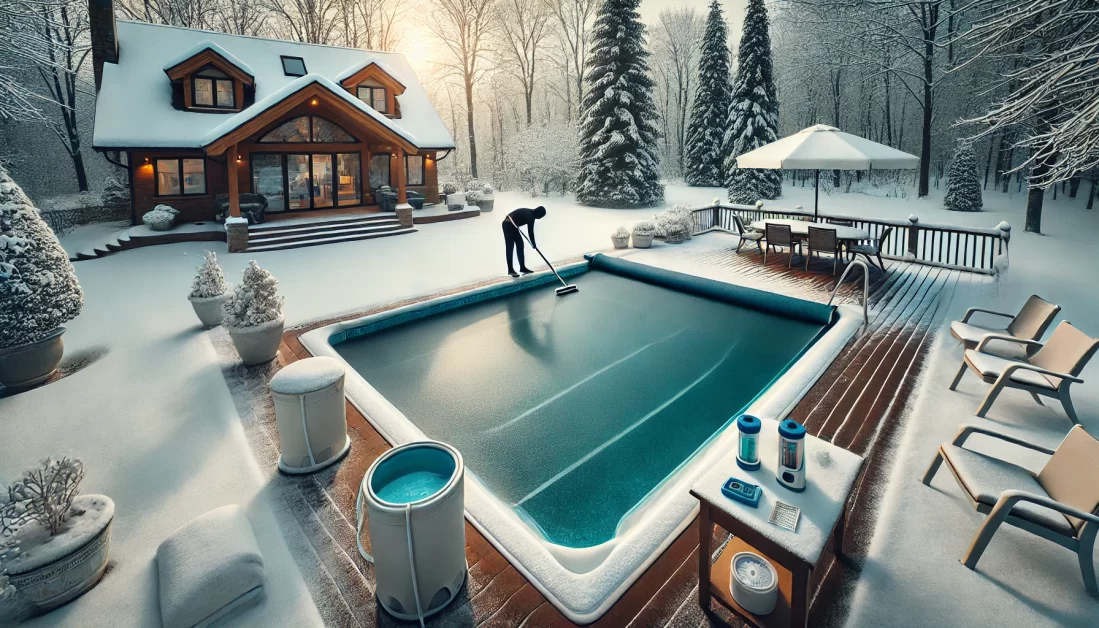
Monitor the Chemical Balance Monthly
Even in winter, your pool’s chemical balance can shift. Test the water’s pH, alkalinity, and chlorine levels once a month, if possible, to ensure everything remains stable. Maintaining proper chemical levels will prevent scaling, staining, and bacteria buildup, making the spring opening much easier.
Check for Any Cover Damage or Sagging
Periodically inspect your pool cover for any signs of wear, tears, or sagging. A damaged cover can allow debris and contaminants into the pool, while sagging may indicate excess weight from water or snow, putting strain on the cover and pool walls.
Remove Snow and Debris from the Cover to Prevent Collapse
Snow, ice, and fallen leaves can add significant weight to your pool cover, causing it to sag or even collapse. Use a broom or pool cover pump to remove snow and standing water regularly, especially after heavy storms. This simple step can prevent costly repairs and prolong the life of your cover.









